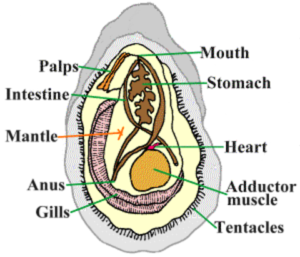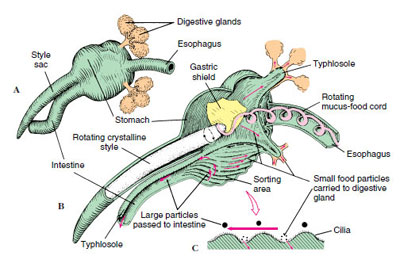
Eastern Oysters were once abundant in Barnegat Bay. Due to over harvesting and disease their numbers have been significantly reduced.
Oyster Anatomy
Eastern Oyster Crassostrea virginica
Oysters are bivalves, meaning that they have a shell consisting of two halves, or valves.
The valves are joined at the top at the hinge.
The hinge has two ligaments.
The external ligament is flexible and provides the axis of movement for the two halves of the shell.
The internal ligament is called the resilium. When the adductor muscle of the oyster is relaxed, the external ligament and resilium work together to open the shell
A single adductor muscle in the center hold the shell closed.
 Inside the shell of an oyster there are eight primary body parts:
Inside the shell of an oyster there are eight primary body parts:
- Mantle – fine fleshy layer of tissue surrounds the oyster’s internal organs
- Adductor Muscle – closes the two valves which open when it relaxes
- Heart – the three-chambered heart pumps colorless blood to all parts of the body
- Gills – extract oxygen from the water – transport food to the mouth
- Mouth – in conjunction with the labial palps either ingest or reject
- Stomach – Particles which enter the digestive tract pass through the esophagus and into the stomach.
- Intestines – primarily involved with temporarily storing and eliminating waste
- Anus – produce streams of water emitted from the oyster’s digestive system
Note: Tentacles are small sensory organs attached to the edge of the mantle used for the detection of environmental stimuli.
Gills together with the mantle are the principal organs of respiration.
Oysters, as well as other bivalve mollusks depend strongly on ciliary action, rather than muscular contraction, to move food through their digestive tracts.
This is important in part because ciliary action is capable of sorting particles according to size and other features.
A second major difference is that in many bivalves, digestion is primarily intracellular (functioning within a cell)
Fun Fact – Unlike clams, oysters do not dig themselves into the bay bottom for protection. They require a hard surface to attach to. This is where they will spend the rest of their lives.
